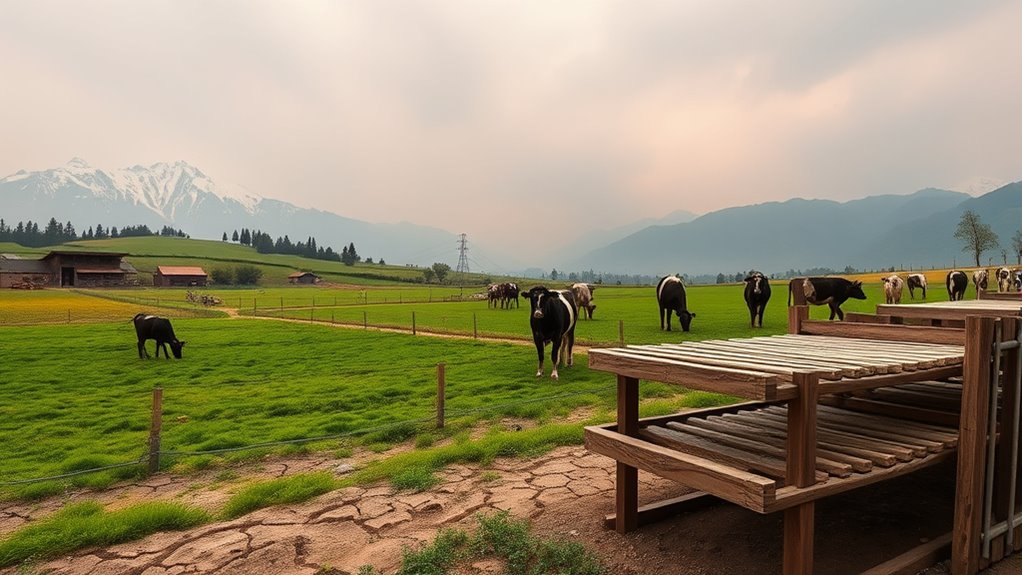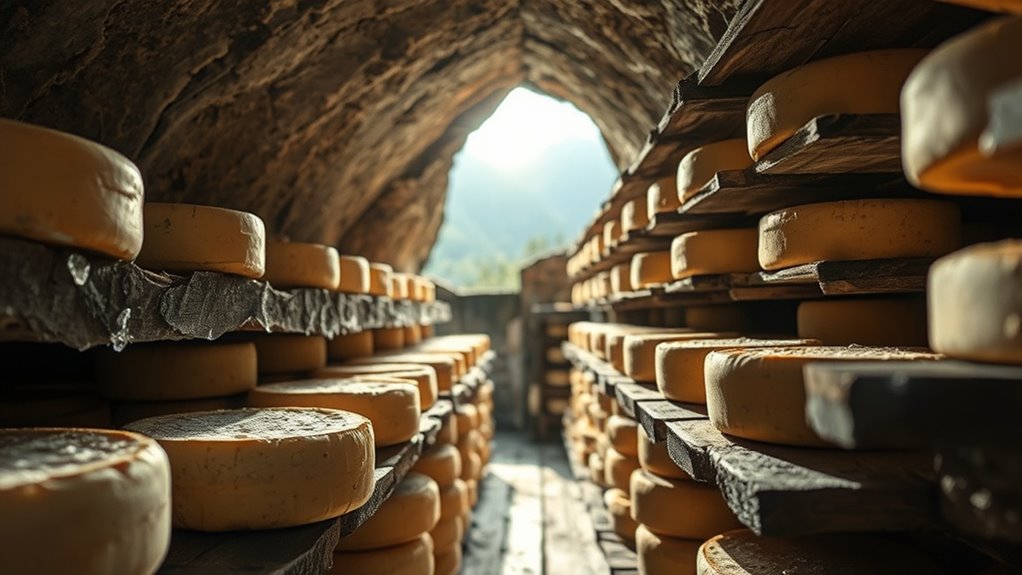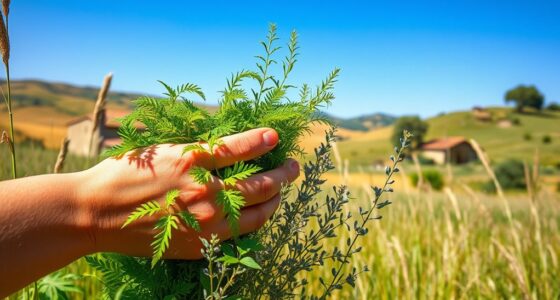Climate change is impacting Italian cheese production by disrupting traditional farming and aging processes. Rising temperatures and unpredictable weather make it harder to grow quality forage, affecting milk yield and flavor. Fluctuating humidity and temperature in aging rooms risk spoilage and inconsistent textures. Livestock health faces new threats, and water scarcity challenges supply. If you explore further, you’ll discover how artisans are working to adapt while preserving Italy’s cherished cheese heritage.
Key Takeaways
- Rising temperatures disrupt traditional cheese aging processes by causing temperature and humidity fluctuations in storage environments.
- Droughts and irregular rainfall reduce pasture quality, impacting milk yield and composition essential for authentic Italian cheeses.
- Climate-induced weather extremes hinder dairy farming schedules, affecting milk consistency and cheese production cycles.
- Increased pests and diseases threaten livestock health, leading to lower milk quality and challenges in maintaining cheese standards.
- Adaptation efforts risk altering cheese flavors and textures, raising concerns about preserving Italy’s cheese heritage amid environmental changes.

Climate change is increasingly threatening Italy’s cherished cheese traditions, as rising temperatures and unpredictable weather patterns disrupt dairy farming and cheese production. You may notice that the landscape and climate conditions crucial to traditional cheese methods are shifting, making it harder for farmers to maintain the quality and consistency of their products. Dairy farming challenges are becoming more frequent as heatwaves, droughts, and irregular rainfall affect pasture growth and water availability. When grass and forage become scarce or of lower nutritional quality, milk yields decline, and the flavor profiles of cheeses may also change. These issues force farmers to adapt quickly, often resorting to modern techniques that can sometimes compromise traditional practices.
In regions where cheese-making has been a centuries-old craft, such as Parmigiano-Reggiano or Mozzarella di Bufala, the impact of climate change isn’t just about quantity but also about maintaining the essence of these cheeses. Traditional cheese methods rely heavily on specific environmental conditions, including stable temperatures and humidity levels during aging and fermentation. Fluctuations in weather mean that aging rooms might no longer provide the ideal environment, risking spoilage or inconsistent textures. You might find that cheesemakers need to invest in costly climate control systems to preserve the quality that consumers expect from authentic Italian cheeses.
Furthermore, the unpredictability of weather patterns complicates the sourcing of high-quality milk. Dairy farmers face difficulties in timing their production cycles, as extreme weather can lead to early or delayed milking, disrupting established routines. Increased incidence of pests and diseases, fueled by changing climatic conditions, also threaten livestock health, further exacerbating dairy farming challenges. When milk production becomes irregular or declines, traditional cheese methods—such as aging cheese for months or years—are put at risk, as the consistency and safety of the final product become harder to guarantee.
These combined factors push you as a consumer or producer to reconsider the future of Italy’s cheese heritage. While some farmers might innovate with new techniques or select more resilient livestock and crops, such changes could alter the flavor and character of the cheeses you love. Preserving Italy’s cheese traditions amid climate change demands both adaptation and careful stewardship, ensuring that these iconic products can be enjoyed by future generations without losing their authentic identity.
Frequently Asked Questions
How Are Traditional Cheese-Making Methods Adapting to Climate Shifts?
You see, traditional cheese-making methods are evolving as climate shifts challenge dairy farms. Producers adopt sustainable practices, like using local feed and renewable energy, to reduce environmental impacts. They also refine traditional techniques to adapt to changing milk qualities and weather patterns. By balancing heritage with innovation, you can help preserve authentic cheese-making while supporting environmental resilience in the face of climate change.
What Specific Italian Regions Are Most Impacted by Climate Change?
You’ll notice that Alpine pastures in regions like Trentino and South Tyrol are most affected, with unpredictable snow and warmer summers disrupting grazing. Coastal dairies along Liguria and Sicily face challenges from rising sea levels and droughts, impacting milk production. These climate shifts threaten traditional cheese-making, forcing producers to adapt their practices and seek sustainable solutions to preserve Italy’s rich cheese heritage.
Are There Any New Cheese Varieties Emerging Due to Climate Influences?
You might think climate change only causes problems, but it’s also sparking climate-driven innovations in cheese. You’ll find new cheese varieties emerging as farmers adapt to shifting conditions, experimenting with different milk sources and aging techniques. Ironically, these climate influences push artisans to be more creative, blending tradition with innovation. So, climate change isn’t just a threat—it’s also inspiring exciting new cheese varieties that could redefine Italy’s cheese scene.
How Does Temperature Fluctuation Affect Cheese Aging Processes?
You need precise temperature control during cheese aging to guarantee consistency. Fluctuations in temperature can disrupt the aging process, leading to inconsistent textures and flavors. Maintaining stable conditions helps preserve aging consistency, allowing the cheese to develop its intended taste and quality. Without proper temperature regulation, cheeses may age unevenly, affecting their final characteristics and overall quality, which is vital for producers and consumers alike.
What Government Policies Support Cheese Producers Facing Climate Challenges?
Think of government policies as a sturdy shield for cheese producers battling climate storms. You’re supported through government subsidies that ease financial burdens and foster innovation, helping you build climate resilience. These policies encourage sustainable practices, safeguard traditional cheese-making, and guarantee your craft endures despite environmental upheavals. As a producer, you benefit from this proactive support, turning climate challenges into opportunities for growth and preservation of Italy’s rich cheese heritage.
Conclusion
If you care about Italy’s rich cheese heritage, you must act now. Climate change is threatening to wipe out centuries of tradition in a blink of an eye, and if we don’t make changes, future generations might never taste the authentic flavors you cherish. Every small action counts—your choices can help protect these ancient recipes from vanishing forever. Don’t let climate change silence Italy’s cheese legacy; it’s a fight we can’t afford to lose.









